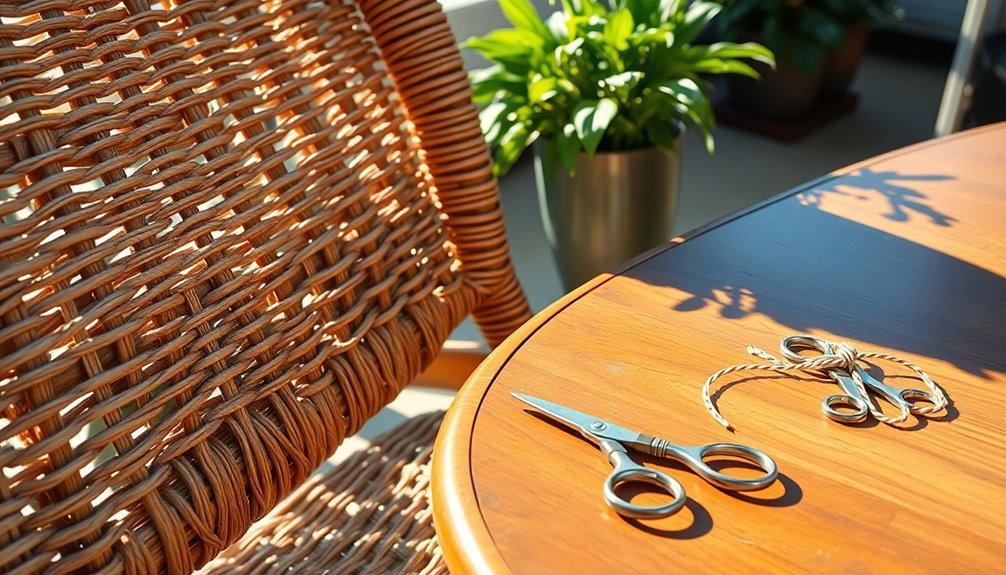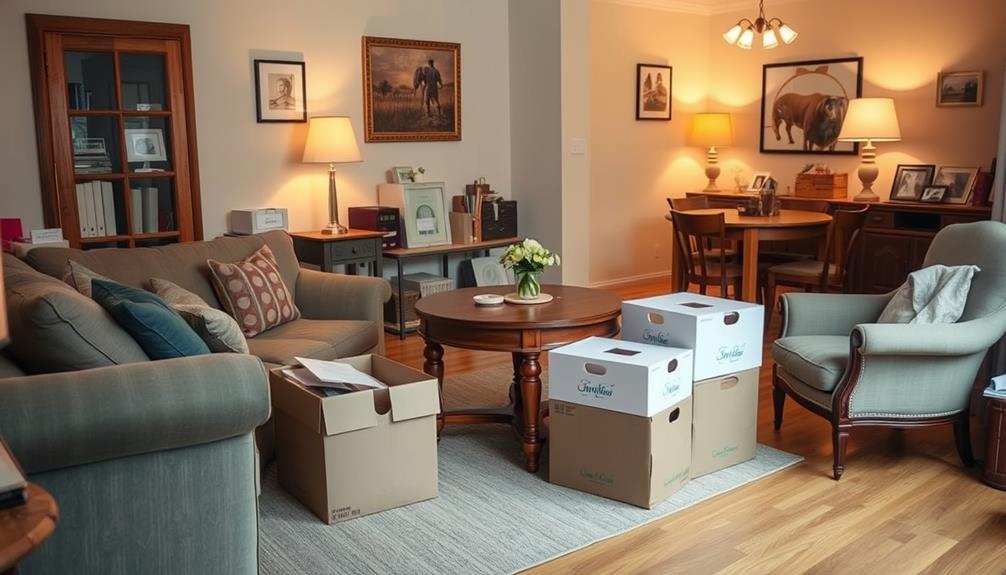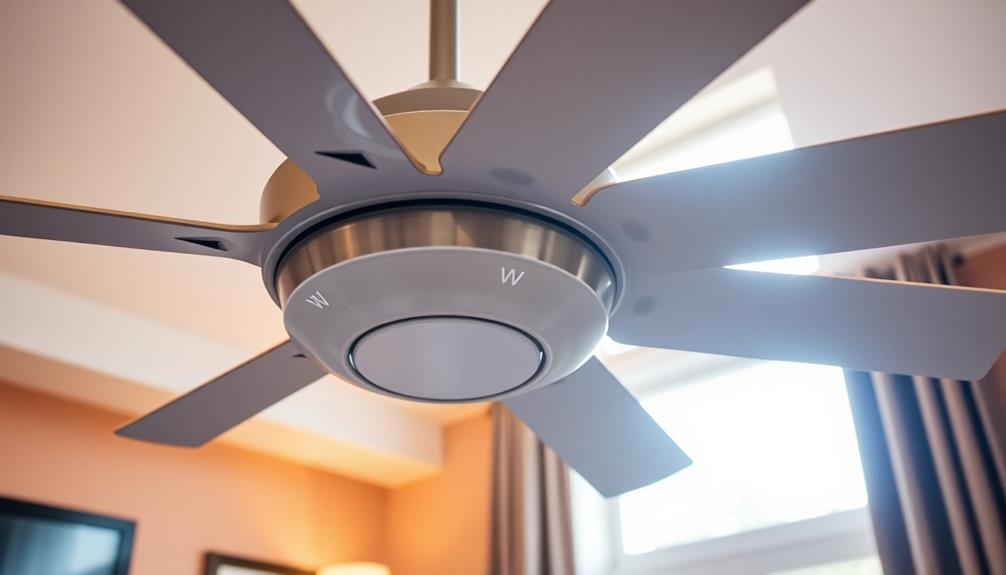Fixing wicker patio furniture is easy if you follow these steps. Start by assessing the damage—look for broken weaves, cracks, and any discoloration. Clean the furniture with mild soap and water, then let it dry. For loose or broken weaves, use pliers to remove damaged pieces and replace them with new synthetic rattan, following the original pattern. Secure them with adhesive and let it dry. If you find cracks, fill them with wood glue or oil to prevent further drying. Sand and paint the repaired areas for a fresh finish. Keep going to uncover additional tips for a successful repair!
Key Takeaways
- Assess the condition of the wicker furniture by checking for damage, fading, and loose weaves before starting repairs.
- Clean the furniture thoroughly using mild soap and water, and address mold or mildew with vinegar solutions.
- Replace broken or loose weaves by removing damaged pieces, measuring new synthetic rattan, and weaving it back into the original pattern.
- Repair cracks and splits by applying wood glue or filler, and reinforcing weak frames with braces as needed.
- Finish repairs by sanding smooth, and consider painting or applying varnish for added protection and aesthetic appeal.
Tools and Materials Needed
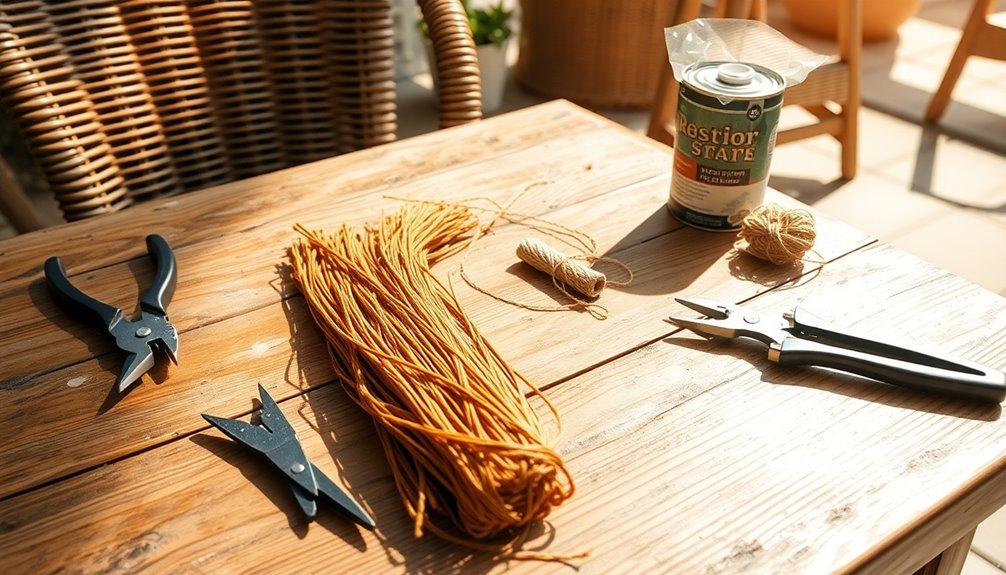
Before you dive into fixing your wicker patio furniture, gather the right tools and materials to make the process smooth and efficient. Start with essential tools like scissors or a box cutter for cutting broken rattan strips, pliers for manipulating wicker strands, and a chisel or screwdriver for removing any damaged pieces. Don't forget gloves to protect your hands during repairs and needle-nose pliers for those tricky spots.
Next, collect your materials. You'll need synthetic rattan or wicker that matches the original color and size. Quick-set wood glue or resin epoxy will secure new strips effectively. A weave tool helps you integrate new rattan into the existing pattern. For touch-ups, have paint and a brush ready to blend any new additions with the old. Additionally, consider the quality of rattan you choose, as it affects the durability and longevity of your repairs.
Consider additional supplies like flat fibre or reed for seat weaving and wicker repair kits that include everything you'll need. Waterproof adhesive ensures durability in outdoor conditions, while a soft brush or cloth will help you clean the furniture before you begin. With these tools and materials at hand, you're set to tackle your wicker furniture repair project.
Assessing the Condition
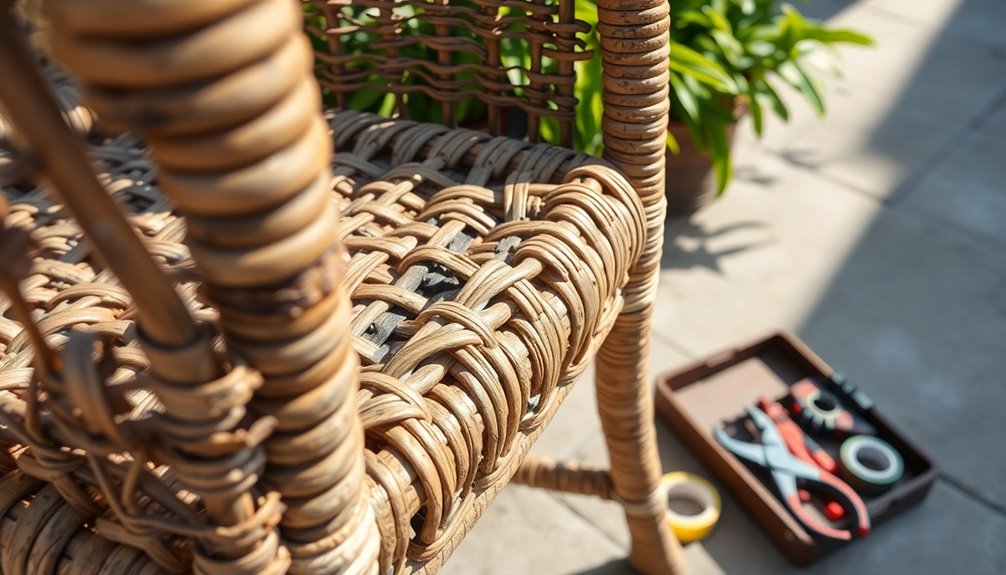
Assessing the condition of your wicker patio furniture is crucial for a successful repair. Start by evaluating the entire piece for any damage, including the frames, weaves, and additional components. Check for fading or discoloration from sun exposure, and identify any broken or loose weaves, marking these areas for repair. Look for cracks and splits in the wicker, especially in sections exposed to harsh weather, and note any signs of mold, mildew, or rot in natural wicker furniture.
Next, inspect the metal frames for scratches, rust spots, or bent components. For wooden frames, check for fading, splitting, and cracking. Ensure all fasteners are secure, as loose or missing ones can compromise the structure. Verify that the frame remains sturdy and can support the intended weight.
Finally, focus on the wicker itself. Assess the extent of any loose or broken strands, noting areas with cracks due to dryness. Look for gaps or irregularities in the weave and determine if any sections are beyond repair. This comprehensive assessment will guide your repair process, ensuring you prioritize what needs immediate attention. Additionally, remember that all-weather wicker is designed to be more resistant to outdoor elements, making it a great option for lasting durability.
Cleaning and Preparing the Surface
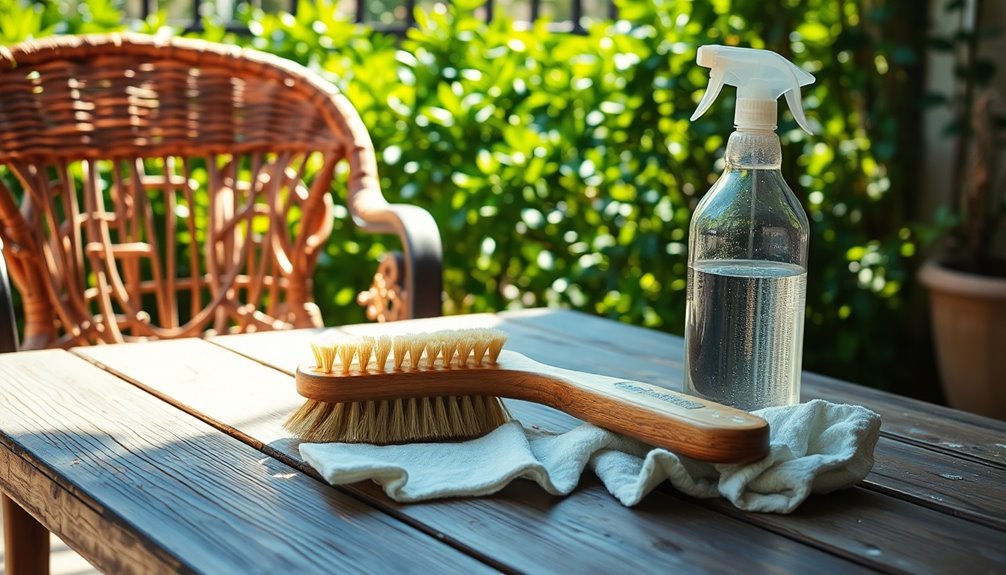
Once you’ve thoroughly assessed the condition of your wicker patio furniture, it’s time to clean and prepare the surface for repairs. Start by dusting the furniture with a soft bristle brush or a dry cloth, paying special attention to crevices where dust accumulates. Avoid using stiff brushes that could scratch the weave. You can also use a vacuum cleaner with a brush attachment on a low suction setting to remove dust effectively. After cleaning, check for any loose connections or damage that may require fixing before proceeding. Additionally, consider researching how to secure patio furniture during harsh weather to ensure longevity and prevent any potential damage from strong winds or heavy rain. Taking these precautions will help sustain the integrity of your patio set while keeping it looking its best.
Next, mix one tablespoon of mild dish soap or non-bleach laundry detergent with two cups of warm water. Use a soft cloth or sponge to apply the solution, scrubbing gently, especially in the cracks of the weaves. Rinse the area thoroughly with a clean damp rag to avoid soap buildup. Additionally, keeping your furniture well-maintained through quality maintenance can help preserve its appearance and longevity.
If you spot any mold or mildew, clean it with a solution of equal parts white vinegar and warm water. For stubborn spots, a paste of warm water and baking soda can help. After cleaning, allow your furniture to air dry completely in a shaded area. To protect your wicker, consider applying a coat of furniture polish or a clear varnish recommended by the manufacturer.
Replacing Broken or Loose Weaves

When you notice broken or loose weaves on your wicker patio furniture, it's essential to address them promptly to maintain its appearance and structural integrity. Start by identifying and marking the damaged areas. Use pliers or a weaving tool to remove any broken or loose pieces of wicker. Carefully cut the damaged strands, ensuring not to harm the surrounding area. Remove one damaged reed at a time to keep the original weaving pattern intact.
Next, measure the length of new material needed and soak it in warm water for about 30 minutes to make it pliable. When you're ready, begin weaving the new reed into place, following the same pattern as the original. Leave extra length on one end to overlap with the existing wicker. Use a curved weaving tool to navigate tighter spots without pulling too tightly, which could warp the new strands. Additionally, ensure that the replacement wicker yarn matches the original material for a seamless repair.
Finally, apply high-quality adhesive to secure the new reeds and trim any excess length. Make sure to overlap the new and old pieces adequately and hide them under perpendicular reeds. Allow the glue to dry completely before using the furniture again, ensuring a solid repair.
Repairing Cracks and Splits
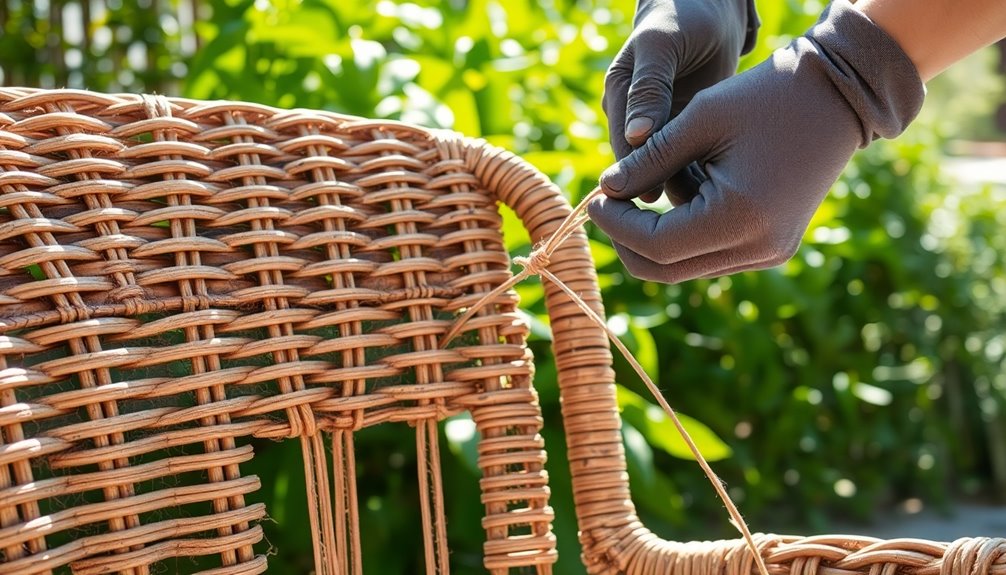
Cracks and splits in your wicker patio furniture can compromise both its aesthetic appeal and structural integrity, so addressing these issues quickly is crucial. Start by inspecting your furniture for any damage. Clean the area with a soft brush and mild detergent, then rinse and dry it thoroughly. Mark the locations of cracks or splits to plan your repairs effectively.
For minor cracks, apply a bit of oil to moisten the area and prevent further drying. Use weather-resistant wood glue or a glue gun to fill the cracks, then clamp the pieces together until the glue dries, following the manufacturer's instructions. For larger gaps, fill them with wood filler that matches your furniture's color and sand it down once dry. Additionally, regular maintenance, including preventing wear, is essential to prolonging the life of your wicker furniture.
If the frame feels weak, reinforce it with wire or metal braces secured with screws. Tighten any loose screws or bolts and apply a waterproof adhesive to ensure durability. Finally, sand the repaired areas for a smooth finish, and consider painting or refinishing to protect your furniture further. Regularly inspect and clean your furniture to maintain its condition and prevent future cracks and splits.
Frequently Asked Questions
Can I Use Regular Glue Instead of Wood Glue for Repairs?
You can't use regular glue instead of wood glue for repairs. Regular white glue isn't strong enough to bond wood or wicker effectively, leading to weak connections. It won't withstand outdoor conditions, risking further damage. Instead, opt for wood glue or polyurethane glue, specifically designed for these materials. They provide the necessary strength and durability, ensuring your repairs hold up against moisture and UV exposure. Choose wisely to maintain your furniture's integrity.
How Can I Prevent Future Damage to My Wicker Furniture?
To prevent future damage to your wicker furniture, you'll want to keep it clean and covered. Dust it regularly, and use mild detergents for deeper cleaning. Invest in waterproof covers to shield it from the elements, and store it indoors during harsh weather. Ensure it's in a shaded area to avoid sun damage, and inspect it frequently for any signs of wear or moisture damage. Being proactive will extend its lifespan significantly.
Is It Safe to Use My Wicker Furniture Outdoors After Repairs?
Yes, it's safe to use your wicker furniture outdoors after repairs, as long as you've done them properly. Ensure you've used high-quality adhesives and matched materials for durability. Applying a UV-resistant resin coating can add extra protection. To maintain its condition, consider using protective covers and placing the furniture in shaded areas. Regular maintenance will help you enjoy your wicker furniture outside without worrying about future damage.
What Is the Best Way to Store Wicker Furniture During Winter?
To store wicker furniture during winter, clean it thoroughly and ensure it's completely dry. If you can, keep natural wicker indoors to protect it from harsh weather. For synthetic wicker, a covered outdoor area works, but elevate it off the ground. Use breathable covers to shield against moisture while allowing airflow. Regularly check on your furniture to keep it dry and free from pests. Following these steps will help maintain its condition.
How Often Should I Clean My Wicker Patio Furniture?
You should clean your wicker patio furniture regularly to keep it looking great. Dust it at least once a week to prevent dirt buildup. Once a month, give it a thorough clean with a damp cloth and mild soap solution. Additionally, perform a deep clean every season, especially after significant weather changes. This routine helps maintain the furniture's condition and extends its lifespan, ensuring you can enjoy it for years to come.
Conclusion
Now that you've tackled the repairs on your wicker patio furniture, it's time to enjoy the fruits of your labor! Regular maintenance and cleaning will keep it looking great while prolonging its life. Remember, a little effort goes a long way in preserving your outdoor space. Don't hesitate to address any future issues as they arise, and your wicker furniture will continue to be a stylish and comfortable addition to your patio for years to come.
